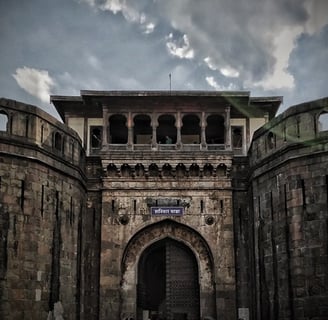This website is available in Hindi or English language
History was not my subject of interest during school days, but I saw a group of young school students standing in a queue inside the Shaniwar Wada Palace premises during my self-guided heritage tour to this nearly 300-year-old building that speaks the glory of the Maratha Empire.
The rise and fall of Shaniwar Wada Palace:
Shaniwarwada was built in the 18th century by the Peshwas. Its construction started on 10th January 1730 and was completed in 1732. Since it was built on Saturday and wada means house, it was named Shaniwarwada.
It is said that the total expenditure on this palace came to Rs 1.5 crore. 16,110/-, and in 1758 AD at least a thousand people lived in the palace area. Bajirao's successors made several additions to the property such as the fort wall with turrets and gates, court halls and other buildings, and added fountains and reservoirs. This building was a seven-storey structure and it is said that it was to be built entirely of stone. However, after the completion of the base floor, the people of Satara objected to the construction of this palace in stone, and were of the opinion that a stone monument could only be sanctioned and built by Shahu (king), not the Peshwas. Following this order, the elevation of the building was done using bricks instead of stones. In 1818, the Peshwas lost control of this seat to the British East India Company. Shaniwar Wada was attacked by the British army, with all the top six floors collapsing and only the stone base remaining. The remaining structure which can still be seen today was quite robust and survived the British artillery. Shaniwar Wada in the 19th century: After facing defeat in 1818, the Peshwa abdicated his throne to Sir John Malcolm and went to live near Bithoor near Kanpur in Uttar Pradesh as a political prisoner of the British government. About ten years after this event on February 27, 1828 a great fire completely burnt down the entire palace which lasted for seven days and nothing of this majestic and magnificent building survived the cruel hands of time except the heavy ramparts, strong gateways and buried foundations and ruins which still testify to the rise and fall of a mighty empire. The Nagarkhana situated on top of the Delhi Gate which once sang the glory of the great Peshwas has now become a popular symbol of the city of Pune. Other important buildings of this palace were the Court Hall of Bajirao I, the Dancing Hall, the Ganesh Mahal and the old Mirror Hall.
The “Hazari Karanje” or the fountain of a thousand sprays, was most artistically and ingeniously constructed for the enjoyment and pleasure of the infant ‘Peshwa Sawai Madhavrao’, and was an object of wonder and curiosity. It is in the shape of a lotus flower with 16 petals, each petal having sixteen spouts and its circumference is 80 feet. It is said that there was not a single fountain anywhere in India which had 196 jets, not even in Europe, except the famous fountain of Rome “Fontana de Treville”. Thousands of rainbows were created and broken by the sunlight for his amusement.
It is said that the total expenditure on this palace came to Rs 1.5 crore. 16,110/-, and in 1758 AD at least a thousand people lived in the palace area. Bajirao's successors made several additions to the property such as the fort wall with turrets and gates, court halls and other buildings, and added fountains and reservoirs. This building was a seven-storey structure and it is said that it was to be built entirely of stone. However, after the completion of the base floor, the people of Satara objected to the construction of this palace in stone, and were of the opinion that a stone monument could only be sanctioned and built by Shahu (king), not the Peshwas. Following this order, the elevation of the building was done using bricks instead of stones. In 1818, the Peshwas lost control of this seat to the British East India Company. Shaniwar Wada was attacked by the British army, with all the top six floors collapsing and only the stone base remaining. The remaining structure which can still be seen today was quite robust and survived the British artillery. Shaniwar Wada in the 19th century: After facing defeat in 1818, the Peshwa abdicated his throne to Sir John Malcolm and went to live near Bithoor near Kanpur in Uttar Pradesh as a political prisoner of the British government. About ten years after this event on February 27, 1828 a great fire completely burnt down the entire palace which lasted for seven days and nothing of this majestic and magnificent building survived the cruel hands of time except the heavy ramparts, strong gateways and buried foundations and ruins which still testify to the rise and fall of a mighty empire. The Nagarkhana situated on top of the Delhi Gate which once sang the glory of the great Peshwas has now become a popular symbol of the city of Pune. Other important buildings of this palace were the Court Hall of Bajirao I, the Dancing Hall, the Ganesh Mahal and the old Mirror Hall.
Timings
Shaniwarwada is accessible to the visitors throughout the week. The average hours of visitation generally spans between 9:00 AM to 6:00 PM; however, it is better to make ones visit earlier in the day. This is also because the site itself is very beautiful in the morning and while one is heading back when the sun is setting to illuminate the fort walls.
### Historical Importance
Peshwa Baji Rao I built it as his residence and the seat of administration. The fort was primarily built with an array of sourced stones and timber made blocks which divided if not blended Hindu and Islamic ways of constructing buildings. At the zenith of the Fort’s existence it scope was enhanced from a simple burial ground to a place of significant power and authority where important happenings and ceremonial parades took place.
The very word ‘Shaniwarwada’ also means a fort that was constructed on a Saturday. That has been on the timeline of transformation of India since the beginning. Unfortunately, for the most part of it’s existence, the fort has seen turbulence, shifting political allegiances, rise and fall of powers, and even sad tragedies. Out of all these incidents, one of the most inexplicable incidents that have been reported concerning the fort is that of young Narayan Rao, the prince heir, who was killed by a treacherous conspiracy, and there are still stories of the haunting ever since.
Within the walls, one can find the remains of the palaces, gardens, and halls that were once teeming with activity. The architecture of the fort included developments of that period gone by and their engineering quite advanced, such as the water system that brought water from a river for use in the fort. The facades, which have deteriorated over time, still captures the grace and class that was associated with the era of the Peshwas.
One of the memorable experiences while visiting the Shaniwarwada is certainly the ‘Bhau Daji Lad Museum,’ situated above the fort. This museum preserves a collection of artefacts, paintings and Pune related documents which helps in better appreciation of the local history.
Visiting Experience
It is an experience the takes one back in time the moment one enters the Shaniwarwada Fort. The moment you step through the gates of the fort, it is as if all history comes rushing back and surrounds you. The vast area peopled invites engagement as visitors are allowed to walk about the courtyards and take in what remains of these architectural wonders. The fort itself is quite well preserved, with historical displays of the more recent past sic of which every visitor can walk and see.
There are options for guided tours which delve into the fort – its history, architecture and the myths attached to it. Many people also take pleasure in photography with some striking features of the fort as the main subject, particularly for their guests, around the sunset. There are also beautiful gardens around which make it more interesting as one can sit down and think about the cherished past.
Final Remarks
To sum up, Shaniwarwada Fort is a symbol of the Maratha Empire’s glory as well as of the wonderful structures built during that time. The fort is open to all guests every day of the week and offers an experience that allows them to appreciate the historical narrative of Pune. It is the rich history, architecture, and myths related to this place that makes it a must-see for anyone who is on a tour of the area.
Transitional phrases connect disparate paragraphs in amusing and meaningful ways.
As groups of people enter the gate of the fort and meander around the premises, they are forewarned of the fall and the glory of a particular time, not an abstract time, but a time that evolved around the important structure. Curious narratives of power struggle, coupled with beautiful architecture and suspense of the past, are ingredients that make any trip from a tourist a traveler. An architectural structure, Shaniwarwada is a bustling center of Pune’s historical and cultural legacy that encourages each visitor to explore every corner of Indian history.
Shaniwarwada History and Myth


